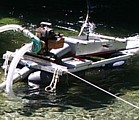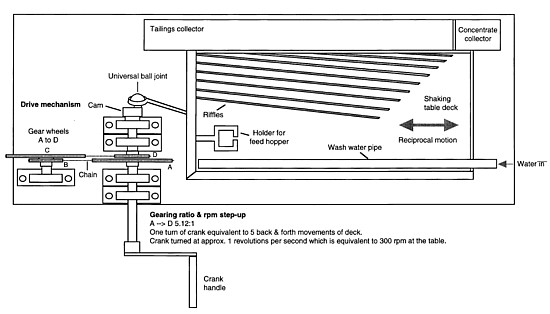Build A Do It Yourself,
Home Made
Gold Shaking Table

.

Build A Do It Yourself,
Gold Shaking Table
|
 |
||
|
. |
Have you wondered about building your own shaking table to recover gold from crushed ores? Interested in building your own gold shaking table for capturing gold and saving some significant money in the process? If you do it right and plan well you really can save a lot of money and still have a good, functional shaking table that is durable and really holds onto the gold - and that counts for a lot. Here are some thoughts about the essential tools, components and skills that you will need to take a look at when planning out the construction of your own home built gold shaking table...... |
 |
|
|
Shaking tables, sometimes also known as wet tables, consist of a vibrating riffled deck mounted on some type of support. A motor, usually mounted separately off to the side, drives a small arm that shakes the table along its length. The riffles are usually not more than half an inch high and cover only about half the table’s surface. Varied riffle designs are available for specific types of applications. Shaking tables are very efficient at recovering heavy minerals from minus 100 microns (150 mesh) down to 5 microns in size. Heavy minerals of a size greater than 150 mesh are better run through a jig. |
||
|
The table is shaken back and forth longitudinally, using a slow forward stroke and a rapid return strike that causes particles to “crawl” along the deck parallel to the direction of motion. The lighter materials move up and over the riffles and down to exit on the tailings side of the table. Wash water is fed at the top of the table at right angles to the direction of table movement. These forces combine to move particles diagonally across the deck from the feed end and they separate out on the table according to size and density. Tables are most commonly used to recover gold from hard rock ores, but can also be used to recover other mineral materials of higher than normal density. They do an excellent job of recovering small gold particles, even with a fairly high feed rate. It has been demonstrated that a simple shaking table is an environmentally friendly method of recovering fine-grained gold from both placer and hard rock gold ore. Such tables can have a significant role in the reduction of the use of mercury by small-scale miners by providing them with an alternative to mercury amalgamation or cyanide for gold recovery. Not many options are out there for the small miners to process his ore in an environmentally friendly and easy to permit manner. This is one potential resolution for this dilemma. |
 |
|
|
On commercially manufactured tables, deck sizes range from 18 by 40 inches for laboratory testing models up to 7 by 15 feet for larger commercial applications. These large tables can process up to 175 tons in 24 hours. The two basic deck types are rectangular and diagonal. Rectangular decks are roughly rectangle shaped with riffles parallel to the long dimension. Diagonal decks are irregular rectangles with riffles at an angle (nearly diagonal). In both types, the shaking motion is parallel to the riffle pattern. The diagonal decks generally have a higher capacity, produce cleaner concentrates, and recover finer sized particles. The decks are usually constructed of wood and linoleum, rubber or plastics usually cover the top of the deck. These materials have a high coefficient of friction, which aids mineral recovery. Expensive, hardwearing decks are made from fiberglass. Both the deck surface and riffles on these units are formed as part of the mold. In operation, a slurry consisting of about 25% solids by weight is fed with wash water along the top of the table. Building a gold shaking table is well within the reach of the home fabricator / prospector. A simple, shaking table can be designed and constructed of cheap materials that are available at a low cost and has a drive mechanism using bicycle gears and chains and rubber bands made from car tire inner tubes. A hand crank powers the drive mechanism of this prototype but it can readily be modified to be powered by a bicycle, motor cycle or a motor, either electric or diesel. Its design was particularly aimed at the recovery of fine-grained gold. Laboratory trials showed that for the separation of fine-grained gold, this simple table was as good as and probably slightly more effective than the commercial Wilfley table. |
||
|
Any home made table needs to be adjustable, allowing a change in tilt for the flow of the material. The surface of the table should be covered with thin sheet rubber. Riffles are about ¼ or 3/8ths of an inch tall and are made from square wood. They are laid down with about one inch between each riffle. While a bicycle gearing system can be used to run the table, it is equally possible to run the table with a motor. Links for a couple of the typical electric motors which would be suitable for this type of project appear at the bottom of the page below. Homemade tables have been tested via field trials, which were generally successful. The fabricated table was easily set up and when properly adjusted to a stable configuration, the heavy mineral concentrates were readily recovered. Field examination during the tests with a hand lens showed that considerable amounts of fine-grained gold had been recovered from the tailings that had previously been processed by the miners’ normal methods. Subsequent laboratory examination revealed that the effectiveness of the simple table was quite remarkable as most of the gold was only around 40 µm in size and grains as small as 10 µm had been recovered. |
 |
|
|
During normal shaking table operations, mineral particles tend to stratify in the protected pockets behind the riffles. The finest and heaviest particles are forced to the bottom and the coarsest and lightest particles remain at the top. These particle layers are moved across the riffles by the crowding action of new feed and the flowing film of wash water. The riffles are tapered and shorten towards the concentrate end. Due to the taper of the riffles, particles of progressively finer size and higher density are continuously brought into contact with the flowing film of water that tops the riffles, as lighter material is washed away. Final concentration takes place in the unriffled area at the end of the deck, where the layer of material at this stage is usually only a few particles deep. The shaking table slopes in two directions, across the riffles from the feed to the tailings discharge end and along the line of motion parallel to the riffles from the feed end to the concentrate end. The latter greatly improves separation due to the ability of heavy particles to “climb” a moderate slope in response to the shaking motion of the deck. The elevation difference parallel to the riffles should never be less than the taper of the riffles; otherwise wash water tends to flow along the riffles rather than across them. Proper operation of these machines also requires some sort of feeder. While building a shaker table is a fairly difficult project, the results can be well worth it. Putting together a project like this will involve some welding of metal parts, and I bought a welder and learned to weld just to be able to do this type of project. I heartily recommend small home welders for folks who like to craft their own projects. Now my welds aren't pretty, but they do the job - they just need to be sturdy and hold the riffles in place. I so strongly recommend that you consider buying one of these welders that I have done up a whole web page on it. If you are seriously considering building your own sluice box, check out my page: Low Cost, Small Arc Welders For Home Use The more tools and fabricating skills you possess, the more likely it is that your home made dredge project will be a success. I have done up a page on the hand tools needed for this type of project, you can check it out at: Mining Project Necessary Tools |
||
|
||
Want to know a little bit more about this crazy prospector guy? Well, here's a little bit more about me, and how I got into prospecting: Chris' Prospecting Story
Gold Sluice, Gold prospecting, home made gold sluice, gold sluice design, gold sluice plans, building a gold sluice, gold sluice riffles, build your own sluice box,